HOW WILL WE LIVE TOMORROW?
Online tour of the Interim Presentation
Welcome to the online tour of the Interim Presentation of the IBA_Vienna "How will we live tomorrow?".
The exhibition took place from 8 September to 22 October 2020 at WEST, in the former Sophienspital.
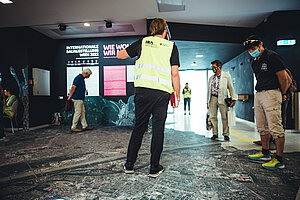
We are aware that many people, both in Austria and abroad, would have been interested in the interim presentation of the IBA_Vienna, but due to current travel restrictions and the necessary caution they did not have the opportunity to visit it. During the last days of the interim presentation, we therefore organised a guided tour of the exhibition, accompanied by a film, in order to present the contents in five parts, irrespective of the time or space constraints. Take a look for yourself...
Guided online tour
Introduction
Exhibition tour part 1 of 5
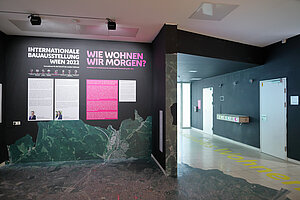
Vienna stands for outstanding quality of life worldwide. One of the main reasons is that Vienna consistently puts the social aspect, and thus the people of this city, at the centre of all fundamental programmes and decisions. Especially in the area of housing and construction, it is a multitude of measures that closely interlock and thus form a basis for the population to live contentedly in the city. High standards for housing and building, clear requirements for the awarding of subsidies and balanced utilisation concepts at the planning level lead to successful social mixing. In order for social cohesion to grow from this, special living and housing needs must be specifically addressed and sometimes active support must also be offered.
Neighborhood Development
Exhibition tour part 2 of 5
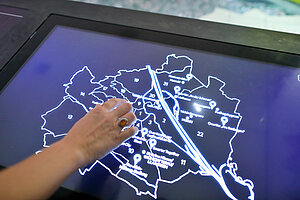
Neighborhoods, or Grätzel in Viennese German, form the hub for social interaction in a city and play a special role, which must therefore be constantly developed with just as much care. The issues of commercial zones, the supply of public transport, the possibilities for leisure activities, meeting places and working environments - all this is reflected in the neighborhood and is constantly in a state of flux. It makes a difference whether the children can walk to school - or not; whether one can sit down on a bench with the neighbor while shopping - or not; whether a tailor can rent a small space in the neighboring house - or not; whether a bed niche for a parent is available in the 2-room apartment over the weekend - or not; whether the youngsters are welcome between the buildings - or not... Neighborhood development has countless facets and contributes greatly to the quality of life in the neighborhood. This is why it also takes on a special significance in the frame of the IBA_Vienna.
Affordability & New Forms of Housing
Exhibition tour part 3 of 5
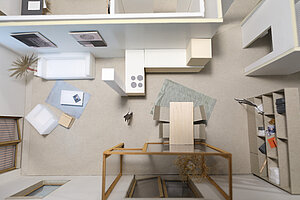
"Housing is a human right." The growth of cities and the resulting rise in demand for housing are contributing to the fact that available building land and living space are becoming increasingly expensive. The principles of non-profit and subsidy systems in housing construction can counteract these price increases, and in doing so create long-term secure housing and rental conditions. Nevertheless, there is a constant need for new and innovative models and needs-based programs that respond to rapidly occurring social changes: in our family structures, our work situations and our social environments. Thus the notion of affordability cannot only be applied to housing. Rather, it is also a question of the affordability of everyday life, of makingends meet with the means available. Affordability of this kind is also linked to expenses for energy, mobility or social services. Hence, to create housing and new living environments for as many people as possible, many smart and sustainable initiatives must be supported and made visible.
Climate Adaption & Ecological Sustainability
Exhibition tour part 4 of 5
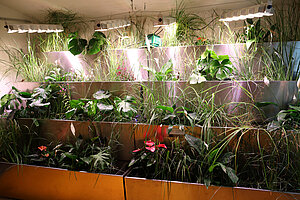
The effects of climate change are becoming increasingly noticeable to us all. The number of hot days in summer is rising, particularly densely built-up urban areas are cooling down perceptibly less at night, and slowly but steadily the flora and fauna are also changing. Vienna "moves" a bit farther south on the European map every year, within 30 years we might record average temperatures of Naples today. In addition to all the measures being taken to counteract the causes of climate change, it is therefore also necessary to respond to its already noticeable effects. In other words: environmentally friendly construction methods, renewable energy systems and the effective prevention of emissions. At the same time, we must provide for more shade, cooling islands, green facades, rooftops and public areas. Together, these measures will ensure that our city remains worth living in for future generations, too.
Developing Existing Housing Stock
Exhibition tour part 5 of 5
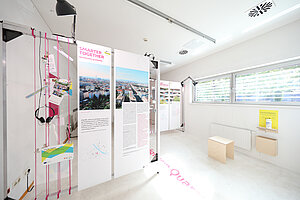
Urban renewal in Vienna is closely associated with areas shaped by the Gründerzeit. However, in the coming years, the further development of existing neighborhoods from the 1950s to the 1970s will become increasingly important. This requires new approaches that go far beyond structural renewal. Innovative technologies in building renovation, climate-friendly energy systems, sustainable mobility offerings, and comprehensive participation are fields of action that need to be addressed at the neighborhood level. The success of this "new" urban renewal depends not least on a broadly supported development vision. What are successful innovations in the areas of redevelopment methods, energy generation and use, and mobility offerings? And which of these innovations has reached feasibility limits? How can acceptance for interventions in existing buildings be achieved through dialog and participatory formats? Which actors need to pull together to achieve this?